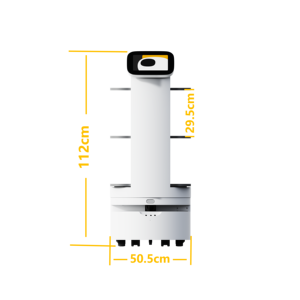(890 products available)

















































































































































































































takeout robot are revolutionizing the hospitality industry by providing an innovative solution for efficient and contactless delivery of goods within commercial spaces. These autonomous machines are designed to navigate complex environments, such as hotels and restaurants, to deliver items like food, beverages, or other essentials directly to guests or staff. Utilizing advanced sensors and artificial intelligence, takeout robot can independently maneuver through busy corridors, elevators, and lobbies, ensuring timely and accurate deliveries. As technology continues to advance, these robots are becoming an integral part of modern commercial operations, enhancing customer experience and operational efficiency.
The variety of takeout robot available in the market caters to a range of operational needs and environments. Some common types include indoor delivery robots, outdoor delivery robots, and hybrid models. Indoor delivery robots are specifically designed to navigate enclosed spaces like hotels, utilizing lidar and camera sensors to avoid obstacles and interact with elevators. Outdoor delivery robots, on the other hand, are built to withstand weather conditions and navigate through pedestrian traffic in urban settings. Hybrid models offer versatility by operating both indoors and outdoors, making them suitable for businesses with diverse delivery requirements. Each type of takeout robot is engineered with specific capabilities to optimize performance in its intended environment.
takeout robot come equipped with a range of functions and features that enhance their utility and reliability in commercial settings. Key functionalities include autonomous navigation, obstacle detection, and real-time tracking. Autonomous navigation systems allow these robots to find the most efficient routes to their destinations, while obstacle detection ensures they can safely navigate around people and objects. Real-time tracking provides operators with the ability to monitor the robots' movements and delivery status. Additional features such as customizable compartments, secure locking systems, and user-friendly interfaces make takeout robot adaptable to various delivery tasks, ensuring secure and efficient transport of items.
The design and functionality of takeout robot rely on sophisticated technological components that work together to ensure seamless operation. Core components include high-definition cameras, lidar sensors, GPS modules, and AI-driven software. The high-definition cameras and lidar sensors enable precise mapping and navigation by providing a comprehensive view of the robot's surroundings. GPS modules facilitate accurate location tracking, essential for route planning and execution. AI-driven software integrates data from these components, allowing takeout robot to make real-time decisions and adapt to dynamic environments. The integration of these technologies ensures that the robots can operate efficiently and reliably in various commercial settings.
To maximize the benefits of takeout robot in a commercial environment, it's important to follow specific operational guidelines. First, ensure that the robots are programmed with accurate maps of the delivery area to facilitate effective navigation. Regular maintenance and updates to the software are crucial to maintaining optimal performance and addressing any potential issues. It's also essential to train staff on interacting with the robots, as human-robot collaboration can significantly enhance efficiency. Consider the strategic placement of charging stations to ensure that takeout robot remain operational throughout the day. By adhering to these guidelines, businesses can ensure the smooth integration of delivery robots into their operations, enhancing service delivery and customer satisfaction.
Selecting the appropriate takeout robot for your establishment involves understanding a variety of factors to ensure optimal performance and integration. First, consider the specific environment where the robot will operate, such as indoor or outdoor settings. Indoor environments like hotels may require robots with advanced navigation systems to maneuver through narrow corridors and interact with elevators, while outdoor environments necessitate weather-resistant models with robust navigation capabilities. Additionally, assess the payload capacity required for your operations. Different takeout robot offer varying load capacities, so it's essential to select a model that can handle the weight and volume of items typically delivered in your business.
Another important consideration is the level of autonomy and technological integration the takeout robot offers. Some models boast advanced AI and machine learning capabilities, allowing them to adapt to dynamic environments and learn from their surroundings. Others may require more manual input for navigation and task execution. Evaluate the level of technological sophistication that aligns with your operational needs and staff capabilities. Furthermore, the ease of integration with existing systems, such as inventory management or customer service platforms, can greatly enhance the efficiency of your operations.
Utilizing takeout robot in commercial environments provides numerous advantages, including increased efficiency, reduced labor costs, and enhanced customer satisfaction. These robots can operate around the clock without fatigue, ensuring timely deliveries and freeing up human staff for more complex tasks. Additionally, their use can lead to a more consistent and reliable service experience for customers.
Safety is a critical consideration for takeout robot operating in busy environments. These robots are equipped with advanced sensors and obstacle detection systems that allow them to navigate safely around people and objects. Their programming includes protocols to stop or reroute when encountering unexpected obstacles, thereby minimizing the risk of accidents and ensuring a safe coexistence with humans.
Yes, many takeout robot models offer customizable features to suit specific business requirements. This can include adjustable payload compartments, branding opportunities with company logos, and programmable routes or delivery schedules. Customization allows businesses to tailor the robots' functionality and appearance to align with their operational and marketing strategies.
Regular maintenance is essential for the efficient operation of takeout robot . This includes software updates, routine checks of sensors and mechanical components, and battery management. Scheduled maintenance helps prevent unexpected downtimes and prolongs the lifespan of the robots, ensuring they remain a valuable asset in the business’s operational framework.
Integration with existing technologies is a key feature of modern takeout robot . Many models are designed to seamlessly connect with inventory management systems, customer service interfaces, and other business platforms. This integration facilitates streamlined operations, real-time data sharing, and enhanced coordination across different business functions.